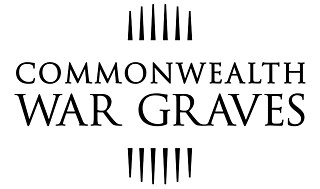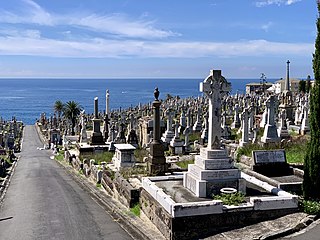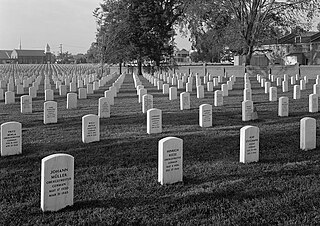
A cemetery is a place where the remains of dead people are buried or interred, it is a type of burial ground. The word cemetery implies that the land is specifically designated as a burial ground and originally applied to the Roman catacombs. The term graveyard is often used interchangeably with cemetery, but a graveyard primarily refers to a burial ground within a churchyard.

Ford Park Cemetery is a 34.5-acre (140,000 m2) cemetery in central Plymouth, England, established by the Plymouth, Stonehouse & Devonport Cemetery Company in 1846 and opened in 1848. At the time it was outside the boundary of the Three Towns and was created to alleviate the overcrowding in the churchyards of the local parish churches. Its official name at the time of inception was The Plymouth, Devonport and Stonehouse Cemetery, although it is now seldom referred to by that title.

The Commonwealth War Graves Commission (CWGC) is an intergovernmental organisation of six independent member states whose principal function is to mark, record and maintain the graves and places of commemoration of Commonwealth of Nations military service members who died in the two World Wars. The commission is also responsible for commemorating Commonwealth civilians who died as a result of enemy action during the Second World War. The commission was founded by Sir Fabian Ware and constituted through Royal Charter in 1917 as the Imperial War Graves Commission. The change to the present name took place in 1960.

Rookwood Cemetery is a heritage-listed cemetery in Rookwood, Sydney, New South Wales, Australia. It is the largest necropolis in the Southern Hemisphere and is the world's largest remaining operating cemetery from the Victorian era. It is close to Lidcombe railway station about 17 kilometres (11 mi) west of the Sydney central business district. It was added to the New South Wales State Heritage Register on 2 April 1999.

The Panteón Civil de Dolores is the largest cemetery in Mexico and contains the "Rotonda de las Personas Ilustres". It is located on Constituyentes Avenue in the Miguel Hidalgo borough of Mexico City, between sections two and three of Chapultepec Park.

The Waverley Cemetery is a heritage-listed cemetery on top of the cliffs at Bronte in the eastern suburbs of Sydney, New South Wales, Australia. Opened in 1877 and built by R. Watkins and P. Beddie, the cemetery is noted for its largely intact Victorian and Edwardian monuments. It is regularly cited as being one of the most beautiful cemeteries in the world. The cemetery contains the graves of many significant Australians including the poet Henry Lawson. Also known as General Cemetery Waverley, it was added to the New South Wales State Heritage Register on 28 October 2016.

Opened in 1852, Mount Royal Cemetery is a 165-acre (67 ha) terraced cemetery on the north slope of Mount Royal in the borough of Outremont in Montreal, Quebec, Canada. Temple Emanu-El Cemetery, a Reform Judaism burial ground, is within the Mount Royal grounds. The burial ground shares the mountain with the much larger adjacent Roman Catholic cemetery, Notre Dame des Neiges Cemetery, and the Shaar Hashomayim Cemetery, an Ashkenazi Jewish cemetery. Mount Royal Cemetery is bordered on the southeast by Mount Royal Park, on the west by Notre-Dame-des-Neiges Cemetery, and on the north by Shaar Hashomayim Cemetery.

The American Battle Monuments Commission (ABMC) is an independent agency of the United States government that administers, operates, and maintains permanent U.S. military cemeteries, memorials and monuments primarily outside the United States.

Ross Bay Cemetery is located at 1516 Fairfield Road in Victoria, British Columbia, on Vancouver Island, Canada. Many historical figures from the early days of the province and colony of British Columbia are buried at Ross Bay.

Anfield Cemetery, or the City of Liverpool Cemetery, is located in Anfield, a district of Liverpool, Merseyside, England. It lies to the northeast of Stanley Park, and is bounded by Walton Lane to the west, Priory Road to the south, a railway line to the north, and the gardens of houses on Ince Avenue to the east. The cemetery grounds are included in the National Register of Historic Parks and Gardens at Grade II*.

Hampton National Cemetery is a United States National Cemetery in the city of Hampton, Virginia. It encompasses 27.1 acres (11.0 ha), and as of 2014, had over 30,000 interments. There are two separate parts to this facility. The original cemetery is called the "Hampton Section" and is located on Cemetery Road in Hampton, VA. It is on the western side of I-64. The new section which is called the "Phoebus Addition" or the "Phoebus Section" West County Street in Hampton, VA east of I-64. It is less than a mile from the original cemetery. Both sections of the Hampton National Cemetery are closed to new interments.

The Old Drift Cemetery is a small burial site near the Zambezi river in modern-day Zambia. It includes the graves of early European settlers and visitors to nearby Victoria Falls who died of causes such as malaria and is located in Mosi-oa-Tunya National Park. Settlers eventually left the area for higher ground, where the town of Livingstone was formed.

Oaklawn Cemetery is the first public burial ground in Tampa, Florida, United States. The location was deeded in the mid-19th century and was described as the final resting place for "White and Slave, Rich and Poor". Oaklawn Cemetery is located at the intersection of Morgan Street and Harrison Street in downtown Tampa, about two blocks South of I-275. It has approximately 1,700 graves.

The St Symphorien Military Cemetery is a First World War Commonwealth War Graves Commission burial ground in Saint-Symphorien, Belgium. It contains the graves of 284 German and 229 Commonwealth soldiers, principally those killed during the Battle of Mons. The cemetery was established by the German Army on land donated by Jean Houzeau de Lehaie. It was initially designed as a woodland cemetery before being redesigned by William Harrison Cowlishaw after the Imperial War Graves Commission took over maintenance of the cemetery after the war.

Andersons Bay Cemetery is a major cemetery in the New Zealand city of Dunedin. It is located 4 kilometres (2.5 mi) to the southeast of the city centre, on a rocky outcrop which forms the inland part of Lawyers Head, a promontory which juts into the Pacific Ocean. The cemetery is bounded on the western and southern sides by Chisholm Park Golf Links, and to the east by steep slopes which descend to the Tomahawk Lagoon. Despite its name, the cemetery is located in the suburb of Tahuna, which lies immediately to the south of the suburb of Andersons Bay, and almost 1 kilometre (0.62 mi) from the former bay itself, at the head of the Otago Harbour.

The United Nations Memorial Cemetery in Korea, located at Tanggok in the Nam District, City of Busan, Republic of Korea, is a burial ground for United Nations Command (UNC) casualties of the Korean War. It contains 2,300 graves and is the only United Nations cemetery in the world. Laid out over 14 hectares, the graves are set out in 22 sites designated by the nationalities of the buried servicemembers.

Cornelian Bay Cemetery is a cemetery in Cornelian Bay, Tasmania, Australia. It is the oldest cemetery in Tasmania that remains in use.

Point of Graves Burial Ground is a small historic cemetery in Portsmouth, New Hampshire, dating to the 17th century. It was the final resting place for many of Portsmouth's prominent residents including the Wentworth family, the Vaughan family, the Rogers, and the Lears. It is the oldest known surviving cemetery in Portsmouth, and one of the oldest in the state. It has about 125 gravestones. Previously neglected, it is now well maintained by the Mayor's Committee and the city. The cemetery plot was on a point of land that directly overlooked the Piscataqua River in earlier times.
Throughout its history, between 3,200 and 6,000 students died while attending the Canadian Indian residential school system. The exact number remains unknown due to incomplete records. Comparatively few cemeteries associated with residential schools are explicitly referenced in surviving documents, however the age and duration of the schools suggests that most had a cemetery associated with them. Most cemeteries were unregistered, and as such the locations of many burial sites of residential school children have been lost. The Truth and Reconciliation Commission of Canada has called for "the ongoing identification, documentation, maintenance, commemoration, and protection of residential school cemeteries or other sites at which residential school children were buried."




















